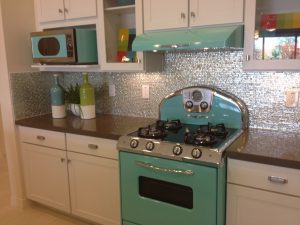The Appeal of Vintage Appliances
Whether you choose to keep your old toaster or buy a vintage refrigerator, a vintage appliance can add some unique character to any kitchen. Vintage machines may lack some of the features and functions of their brand new counterparts, but these appliances were often built to last. A vintage device can complement traditional decor, but they can also be wonderfully showcased in a sleek, modern kitchen.
Is Your Vintage Appliance Safe to Use?
Like any appliance, a vintage model will need some care and attention to ensure that it continues to operate correctly. Unfortunately, an older machine is usually subject to more wear, which can compromise safety. There are some basic checks to check that your vintage appliance is safe to use including inspecting the wiring, gas fittings and cords are still in excellent condition. In some cases, it is safer to simply replace a cord or gas line to have complete confidence.
If there are missing parts or components that need replacing, you need to ensure that you buy from a reputable and knowledgeable dealer with experience in vintage appliances. While you may have access to a store offering a plethora of parts and spares, you need to know that the component can be relied upon.If you are purchasing a vintage appliance and are unsure about its service history, it is a good idea to have an experienced technician perform a safety inspection.
The Potential Safety Issues
If you’re considering installing a vintage appliance, you do need to be aware of any potential safety issues or hazards. Depending on the specific age of the appliance, there may be issues to consider. For example, a 1920s refrigerator would have been designed to use gases rather than Freon. This could result in poisoning or even an explosion if incorrectly installed or operating.
You also need to consider whether the electrical cords are safe with the outlets installed in your home. Many vintage appliances were made using metal, so they may not be grounded. If you want to ensure that they operate safely in your home, you may want to think about plugging your appliance into a GFI outlet. This type of outlet will shut off the power if it senses a power imbalance, reducing the risk of shock, overheating or even fire.
Vintage stoves do not tend to have the modern safety features, we have come to expect, which can be problematic if you have small children in your home. Your vintage stove may not have sealed cooling or electrical components, shatter-proof glass or even anti tip technology, so it could be dangerous around smaller children.
Other Considerations
Finally, you need to consider the availability of replacement parts. The older your vintage appliance, the more difficulty you may have to source components if they need to be replaced. Minor issues such as replacing a heating element can quickly become a headache if you are not prepared for the problem. Therefore, if you are serious about having a vintage appliance, it is a good idea to familiarize yourself with reputable dealers and specialists who can assist you if you need to replace any parts.
There are a number of safety consideration for vintage appliances, so for practical advice, you can rely on a professional home appliance technician to help.
For help with any vintage appliance issues or to arrange an inspection, ensure you speak to a professional appliance repair service.
